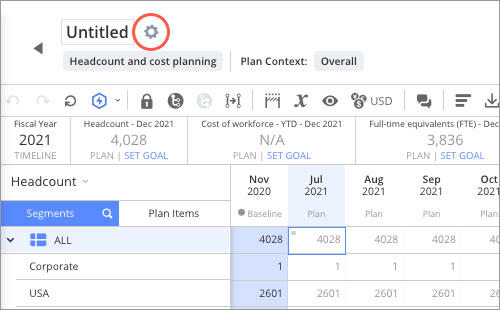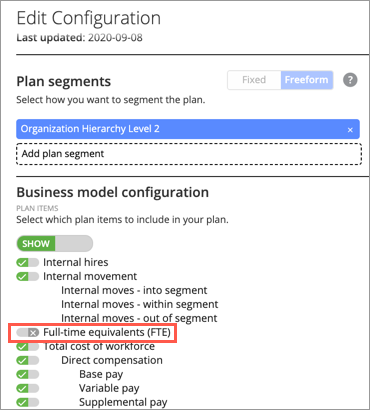Headcount Model
The Headcount model forecasts future hires, internal movement and exits based on projected future headcount and historical headcount data.
Overview
The Headcount model draws on actual past data to mathematically project future headcount. The headcount model allows customers to model the following when planning their future workforce:
- Planning headcount (Headcount plan): Set the target headcount in the model at any level in the organization, or see how the headcount changes as the model inputs change; the planned headcount takes into account attrition and movement and sets the targets for your hiring plan.
- Planning hires (Hiring plan): The model takes into account internal movement, exits to be backfilled and planned headcount growth, in order to determine the number of hires needed to achieve the headcount plan.
- Planning for internal movement: The model determines employees that are expected to move into, out of and within different departments or lines of business, based on historical data. This adds precision to the headcount and hiring plans.
- Planning for attrition: The model determines the attrition that is expected to occur due to retirements, resignations and planned involuntary turnover events. This detail is used in the headcount model and may add hires to the hiring plan to achieve target headcount.
Included plan metrics
The headcount model includes a number of planning metrics that help customers model future headcount targets, hiring plans, movement and attrition.
Hiring metrics: Creating a hiring plan
These are the components of the hiring plan.
The three hiring metrics help predict the hiring demand that will be placed on the talent acquisition team as a result of the headcount plan.
At a high level the hiring metrics are:
- External Hires: The External Hires metric shows the number of external hires needed to reach headcount goal metric shows the number of employees that need to be hired from outside the company to meet headcount goals, taking into account internal employee movement and employee exits/attrition.
- Internal Hires: The Internal Hires metric shows the number of internal hires events that are expected to happen in each future period.
- Total Hires: The Total Hires metric shows how many people the Talent Acquisition team need to hire—from external and internal sources—to meet headcount targets in the plan.
Movement metrics: Understanding future internal employee movement
The four movement metrics model the future movement of employees between departments or lines of business in the company:
- Internal moves - into segment: The number of employee moves that are expected to move into a segment from other segments in the company.
- Internal moves - within segment all levels: the number of headcount that are expected to move within a segment between all child segments beneath it.
- Internal moves - out of segment: The number of headcount that are expected to move out of this this segment to another segment within the company
- Net internal moves for segment: The number of moves the are expected for a given segment or line of business (LOB), taking into account both expected internal moves into, out of, and within the segment.
Exit metrics: Planning for future employee attrition
The Exit metrics model the expected workforce attrition across the different segments and time periods, for employees who are leaving the organization entirely. Total Exits is the sum of Expected Exits and Other Exits:
- Expected Exits: The Expected Exits metric captures the projected number of voluntary and involuntary exit events in the future. This is the sum of Resignations, Retirements, Involuntary Turnover, and Additional Expected Exits.
- Resignations: The Resignations metric allows workforce planners to model the expected number of Resignation events that are projected to happen as a result of employees resigning from the company.
- Retirements: The Retirements metric allows workforce planners to model the expected number of Retirement events that are projected to happen as a result of employees Retiring from the company.
- Involuntary Turnover: The Involuntary Turnover metric allows workforce planners to model the expected number of Involuntary Turnover events that are projected to happen as a result of planned reduction in force (RIF) or layoff programs in the company.
- Additional Expected Exits: The Additional Expected Exits assumption captures exit events that are projected to happen that fall outside of Resignations, Retirements, or Involuntary Turnover.
- Other Exits: The Other Exits metric captures cases where there is an drop in headcount from one period to the next for a segment that is not accounted for by net internal employee movement (out of the segment) or Expected Exits (as captured by the Resignation, Retirement, and Involuntary Turnover planning metrics).
Note: If a subplan includes a new attribute or attribute level, and has values for Other Exits, the Other Exits from the subplan will be counted as Involuntary Turnover when it is consolidated into the main plan. Since we don't know how Other Exits are distributed in the subplan, we need to merge these values into Involuntary Turnover to ensure the Expected Exit metrics (Resignation Rate, Retirement Rate, and Involuntary Turnover Rate) are calculated correctly in the main plan. However if you have the Additional Expected Exits plan item enabled, the Other Exits from the subplan will be counted as Additional Expected Exits instead of Involuntary Turnover when it is consolidated into the main plan. If you don't want Other Exits to be automatically merged into Involuntary Turnover, we recommend that you specify the type of exit in your subplan by adding values for Resignations, Retirements, Involuntary Turnover, or Additional Expected Exits at the lowest leaf levels before submitting your subplan for review.
About the Additional Expected Exits assumption
The Additional Expected Exits assumption is a miscellaneous category that allows workforce planners to capture future exit events that fall outside of Resignations, Retirements, or Involuntary Turnover. This assumption is useful when you have yet to decide which Expected Exits category these exits will fall into when adjusting for Other Exits in your plan. Additional Expected Exits allow you to balance Other Exits without overstating Resignations, Retirements, or the Involuntary Turnover counts.
How to enable the Additional Expected Exits assumption
Your administrator must update the plan item security settings in Studio before you can use this plan item.
If you don't see the plan item in the planning grid and you can't turn it on in the Edit Configuration dialog, do the following:
Step One: Contact your administrator to enable the plan item
Administrators can enable a plan item by setting up plan item security. To set up plan item security in a project, click Security > Plan Item Security on the navigation bar. In Plan Item Security, administrators will select the permissions that can access the plan item. As a result, users who have the assigned permission will be able to use the plan item in their plans. For more information, see Plan item security. After the project is published, the plan item will be enabled by default for all new plans.
Step Two: Turn on the plan item in existing plans
After your administrator has updated and published the plan item security changes, you will have the option of including the plan item in any existing plan. To turn on the plan item, click the Edit Configuration button ![]() in your plan.
in your plan.

In the Edit Configuration dialog, under Business model configuration, click the Plan Item toggle of the plan item you want to show in the plan, and then click Save.

